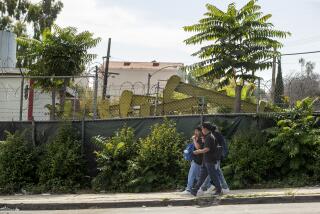New federal ban on deep-water drilling is planned
- Share via
Reporting from Los Angeles and New Orleans — The Obama administration plans within a week to issue a new ban on deep-sea oil drilling to replace a moratorium rejected by a federal court.
On a Friday visit to California, Interior Secretary Ken Salazar defended the six-month moratorium his agency imposed in May and said the difficulties BP has encountered in containing the massive gulf spill and dealing with its blown-out well underscore the need for a pause in deep-sea drilling.
“The moratorium we issued on May 28, in my view, was right then and is right today. I think it’s very legally defensible. I think that the lower court was wrong,” Salazar said Friday on a visit to the Santa Monica Mountains National Recreation Area.
“We will move forward and in the coming days announce a new moratorium decision. It will be within the next week,” he added.
A federal appeals court Thursday declined to put a hold on an earlier lower court order overturning the ban, while the matter is on appeal.
Salazar said the new moratorium decision will incorporate data gathered in recent weeks.
“All the different work … we have been overseeing and been involved in has given us new information on the inadequacy of the ability to contain the ongoing spill at the site of the well, the difficulties in having an oil spill response plan that is effective at protecting ecological values,” he said.
In the meantime, BP teams plan to take advantage of calm weather to start installing a new containment system on the damaged well that could redirect all of the gushing oil to surface ships, effectively ending the leak that has been spewing as many as 60,000 barrels a day since late April.
A BP spokesman said preparations should start Saturday to remove the existing containment device and replace it with a tighter cap that could stop most, if not all, the oil from pouring into the sea.
The current system is capturing about 24,000 barrels a day, still allowing a significant gusher of crude to escape from the well and feed the largest oil spill in U.S. history.
BP also is adding more collection capacity. When fully in place, four separate lines attached to the new device will be capable of funneling 60,000 to 80,000 barrels a day to the surface.
Although the recapping operation will temporarily allow more oil to escape, several collection lines will continue to capture oil during the process, which will take several days to complete.
A tighter seal on the well will allow engineers to get a more accurate reading of the flow, which has been the subject of wildly different estimates since the April 20 blowout.
“I would think that once we have the new capping device on, we should be able to get probably the most accurate flow rate to date,” Coast Guard Adm. Thad Allen said during a New Orleans news briefing.
Crews are also ahead of schedule in drilling two relief wells that will be used to finally “kill” the runaway well by pumping heavy drilling mud into the bottom, then sealing it with cement.
“But because you are dealing with something that is … miles below the surface of the ocean, there are uncertainties,” Salazar said in Malibu. “I think the Aug. 15 timeline [for completion] is an appropriate one. If there are breaks, maybe it will happen sooner. “
The delicate cap replacement operation is the latest in a series of steps the company has taken in the past two months to try to bring its renegade well under control.
A large, collection dome became clogged with gas hydrates, and a “top-kill” attempt to plug the well head with drilling mud failed when the upward force of gas and oil proved too great to overcome.
More to Read
Sign up for Essential California
The most important California stories and recommendations in your inbox every morning.
You may occasionally receive promotional content from the Los Angeles Times.












